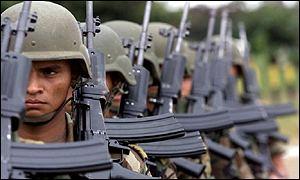 In Colombia the hyper security state is committed to continuing its war in spite of several recent good will gestures by the insurgency, including the unilateral release of a number of its detained prisoners of war and numerous calls by the Revolutionary Armed Forces of Colombia (FARC) and the National Liberation Army (ELN) to embark on the negotiation of a peace accord. Instead, the government of Juan Manuel Santos is still following the U.S.-Israeli designed military strategy of “high value targets” (HVTs). In other words, to assassinate the insurgency’s leadership and mid-level commanders in order to disrupt their command and control structure of the organization. The problem with this strategy is that it was neither successful in occupied Palestine, Lebanon, nor in Iraq and Afghanistan where it was also tested.
In Colombia the hyper security state is committed to continuing its war in spite of several recent good will gestures by the insurgency, including the unilateral release of a number of its detained prisoners of war and numerous calls by the Revolutionary Armed Forces of Colombia (FARC) and the National Liberation Army (ELN) to embark on the negotiation of a peace accord. Instead, the government of Juan Manuel Santos is still following the U.S.-Israeli designed military strategy of “high value targets” (HVTs). In other words, to assassinate the insurgency’s leadership and mid-level commanders in order to disrupt their command and control structure of the organization. The problem with this strategy is that it was neither successful in occupied Palestine, Lebanon, nor in Iraq and Afghanistan where it was also tested.
In Colombia, this HVT strategy was manifested in the killings of Raul Reyes, Mono Jojoy, and now the incessant campaign to kill FARC commander Alfonso Cano, involving several thousand Colombian soldiers alongside the U.S. technical and intelligence services, with possible Israeli involvement. The term “high value target” is a euphemism for targeted assassination, and the practice is employed by superior powers in asymmetrical conflicts. In Colombia—as with the United States and Israel in their respective wars—the strategy has been completely ineffective in defeating the insurgency or in weakening its resolve to fight.
Then, how can we explain the continuation of such a strategy in Colombia and elsewhere?
There are two main interrelated issues to consider in answering this question. The first is that the Santos government’s war posture is sustained by an inflated military establishment tied with the most reactionary factions of the dominant classes (cattle ranchers, large landowners, and the narco-bourgeoisie) and bolstered by continuous U.S. intervention. Together, these forces are determined to continue the war system rather than negotiate a peace accord that could entail social, economic, and political concessions that would undermine the class interests of these groups and U.S. imperialist interests in the Andean region and in Latin America.
The simple equation that governs the war system in Colombia and elsewhere has been: the costs of peace are more than the costs of war, particularly for the dominant classes. This is because the masses at large pay the costs of the war while the privileged groups will pay the costs of a negotiated peace agreement through land and capital redistribution.
This brings us to the second issue. The “high value target” war strategy is not designed to defeat, but to downgrade the insurgencies and peoples resistance to a nuance left in remote areas of the periphery. That is to say, to reduce the threat to an acceptable level, so it is not a menace to the socioeconomic and political order or to colonial domination, as is the case of Palestine.
This may explain the continuation of the HVT strategy in the war systems of occupied Palestine, Iraq, Afghanistan, and in Colombia.

